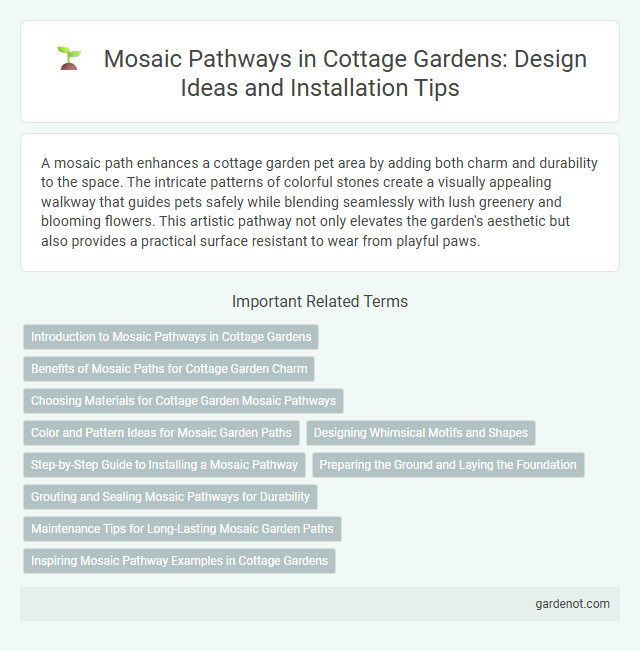A mosaic path enhances a cottage garden pet area by adding both charm and durability to the space. The intricate patterns of colorful stones create a visually appealing walkway that guides pets safely while blending seamlessly with lush greenery and blooming flowers. This artistic pathway not only elevates the garden's aesthetic but also provides a practical surface resistant to wear from playful paws.
Introduction to Mosaic Pathways in Cottage Gardens
Mosaic pathways in cottage gardens create vibrant, artistic walkways using colorful tiles, stones, or glass pieces arranged in intricate patterns. These paths enhance the garden's rustic charm while providing durable and visually appealing routes through flower beds and greenery. Incorporating mosaic elements encourages creativity and adds unique texture, harmonizing with the informal, natural style typical of cottage gardens.
Benefits of Mosaic Paths for Cottage Garden Charm
Mosaic paths enhance cottage garden charm by providing visually appealing, intricate designs that complement natural elements and create focal points throughout the space. The use of varied stones, tiles, and glass pieces offers durability and low maintenance while promoting drainage and preventing soil erosion. These artistic walkways increase garden accessibility and invite leisurely exploration, boosting overall aesthetic and functional value.
Choosing Materials for Cottage Garden Mosaic Pathways
Selecting durable materials such as natural stone, recycled glass, or terracotta tiles enhances the charm and longevity of cottage garden mosaic pathways. Incorporating locally sourced stones adds authenticity and blends seamlessly with the rustic aesthetic of cottage gardens. Opt for non-slip, weather-resistant materials to ensure safety and enduring beauty in all seasons.
Color and Pattern Ideas for Mosaic Garden Paths
Vibrant mosaic garden paths create enchanting focal points in cottage gardens, using a rich palette of blues, greens, and earthy tones to harmonize with floral surroundings. Intricate patterns such as spiral swirls, geometric tessellations, and natural motifs like leaves or flowers elevate the sensory experience. Combining contrasting textures and colors enhances the visual depth, guiding visitors through the tranquil garden setting.
Designing Whimsical Motifs and Shapes
Crafting mosaic paths in cottage gardens involves selecting vibrant, weather-resistant tiles to form whimsical motifs and shapes that enhance the garden's charm. Intricate patterns like floral designs, butterflies, and abstract swirls evoke a playful yet timeless aesthetic, guiding visitors through lush greenery. Incorporating natural stone pieces with colorful ceramics creates textured surfaces that blend seamlessly with blooming borders and rustic garden elements.
Step-by-Step Guide to Installing a Mosaic Pathway
Creating a mosaic pathway in a cottage garden begins with selecting durable, weather-resistant materials such as natural stone, ceramic tiles, or recycled glass. Start by preparing a compacted base with gravel and sand to ensure stability, then carefully lay out your mosaic design using a chalk outline or pattern template. Secure each piece with outdoor adhesive, fill gaps with grout, and seal the surface to protect against moisture and wear, resulting in a vibrant, long-lasting garden feature.
Preparing the Ground and Laying the Foundation
Preparing the ground for a mosaic path in a cottage garden involves clearing debris, leveling the soil, and compacting it firmly to create a stable base. Laying a foundation typically requires spreading a layer of crushed stone or gravel followed by a sand bed to ensure proper drainage and support for the mosaic tiles. This solid groundwork prevents shifting and enhances the durability and aesthetic appeal of the mosaic pathway.
Grouting and Sealing Mosaic Pathways for Durability
Proper grouting in mosaic pathways ensures stability by filling gaps between tiles, preventing water infiltration and shifting over time. Sealing the grout with a high-quality, weather-resistant sealant protects against moisture, mold, and staining, significantly extending the pathway's lifespan. Regular maintenance of grout and sealant preserves the vibrant appearance and structural integrity of cottage garden mosaic paths.
Maintenance Tips for Long-Lasting Mosaic Garden Paths
Regularly sweep the mosaic path to remove debris and prevent moss or algae buildup, which can cause slipperiness and damage. Seal the grout and tiles annually with a high-quality sealant to protect against moisture penetration and fading from UV exposure. Repair any cracked or loose tiles promptly to maintain the structural integrity and aesthetic appeal of the mosaic garden path.
Inspiring Mosaic Pathway Examples in Cottage Gardens
Mosaic paths in cottage gardens create vibrant, artistic walkways using colorful tiles, stones, and glass pieces that add texture and visual interest to outdoor spaces. Popular examples include irregular pebble mosaics combined with floral patterns, vintage ceramic shards arranged in whimsical designs, and natural stone mosaics incorporating local materials to blend harmoniously with lush garden beds. These inspiring mosaic pathways enhance the rustic charm and personalized aesthetic typical of traditional cottage garden landscapes.
Mosaic path Infographic

 gardenot.com
gardenot.com